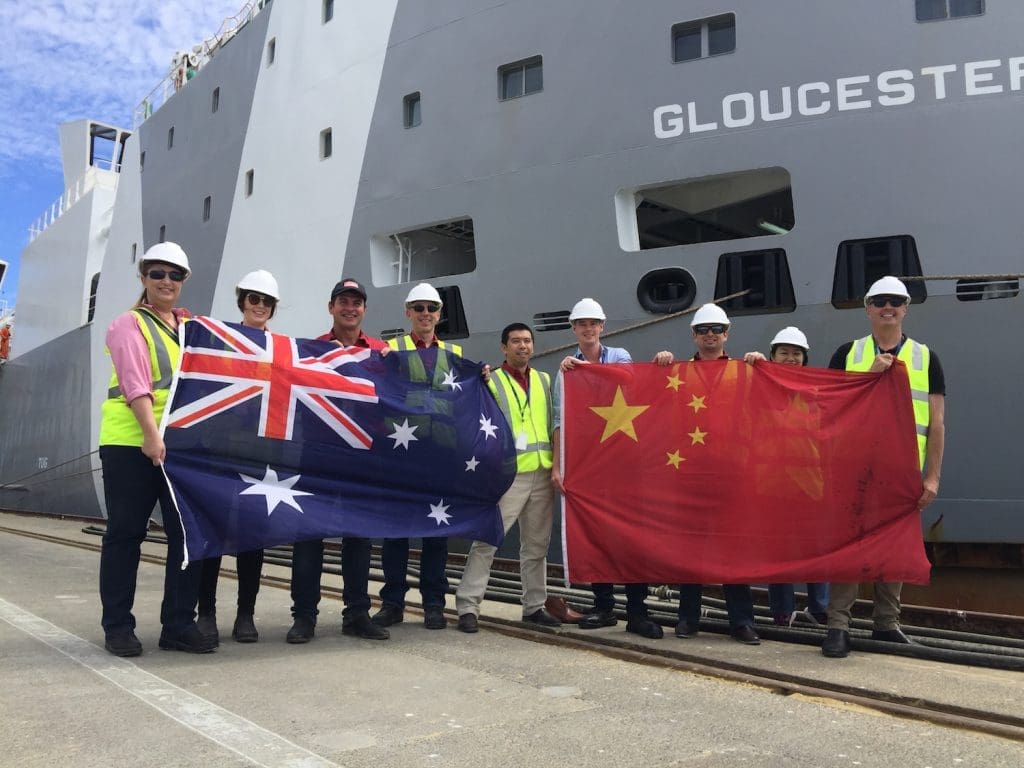
The first sea shipment of Australian slaughter cattle to China was shipped by NACC in February this year.
A WAVE of direct investment by Chinese and other Asian companies into Australian livestock exporting businesses has been a prominent trend in the livestock export sector this year.
This in a year when Australian livestock exporters have faced continued serious challenges to profitability caused by tight supplies of cattle, high Australian cattle prices and reduced orders from the key markets of Indonesia and Vietnam.
New players have also increased competitive pressure in the sector at a time when total feeder and slaughter cattle exports have declined by 23 percent compared to the previous year.
Despite these challenges, the past year has seen new investors from China and Singapore either acquire stakes in several Australian livestock exporting companies or launch new ones:
- In April, China’s Fulida Group became the majority shareholder in Australia’s largest livestock exporting company Wellard. Fulida bought half of the Wellard shares owned by founder and CEO Mauro Balzarini in September 2016, and expanded its stake via a Wellard capital raising program in April to 130 million shares, now holding about 24.5 percent of Wellard’s voting shares.
- In June, Elders sold its live export business – the North Australia Cattle Company (NACC) – to Zhoushan Fanda Australia Cattle Co, a partnership owned by Chinese investors and the Australian managers of NACC.
- Chinese investment has also come into the livestock export industry via the establishment of a new player, Phoenix Exports, the export division of Harmony Agriculture and Food Company (HAAFCO), an agribusiness jointly-owned by Australian investors and Chinese partner Hopshun Australia.
- In November livestock exporter South East Asian Livestock Services (SEALS) announced that Singapore-headquartered Yarra Corporation had taken a ‘controlling stake’ in the company. Yarra Corp’s business is geared to sourcing Australian produce for Asian markets, with a strong emphasis on China, where it has its own meat processing facility and distribution network.
- A related investment in the Australia-China live export supply chain was the agreement announced in May between Gina Rinehart’s Hancock Prospecting and Chinese company Zhejiang Aozhou Cattle Industry Co Ltd, to develop a feedlot and processing centre for imported cattle on Jintang Island near Shanghai.
- Shanghai Cred, the 33pc joint venture owner of S Kidman and Co along with Ms Rinehart’s Hancock Prospecting which owns 67pc, was the importer behind the the inaugural sea shipment of beef slaughter cattle from Australia to China in February, shipped by NACC.
So what is driving this investment interest in a sector currently facing serious challenges to profitability?
In short, what investors see as a positive outlook for the future of the developing trade in beef slaughter cattle – and potentially soon feeder cattle too – from Australia to China.
Several Chinese cattle importing companies – including some of those listed above – have also been investing heavily to build brand new feedlot and abattoir facilities close to Chinese ports to support the new trade, which was opened with the signing of a protocol between both countries in 2015.
It has taken a few years for the various commercial players involved to get the infrastructure required under the new protocol in place, but recent developments show the long-hyped new trade is starting to build momentum.
Australia’s first sea shipment of slaughter cattle to China in February – a 1200 head consignment shipped by NACC – has been followed in recent months by the export of a further 6000 or so cattle in three shipments to China by Wellard, Phoenix and Frontier.
Another one or two sea shipments are also believed to be close to being sent from Australia soon.
Agribusiness consultant and Australian Livestock Exporter’s Council board member Cameron Hall has significant experience in Australia’s livestock export industry with Elders, Landmark and Livecorp, and coordinated Australia’s first air-shipment of beef slaughter cattle to China in 2016 for Elders.
Mr Hall said the recent wave of investment into Australia’s livestock exporting sector reflected the positive view Chinese market participants have in the future of the emerging trade, and their desire to have integrated investments throughout the supply chain.
“I think there is a view that there is a positive long term future around the supply feeder and slaughter cattle,” Mr Hall said.
“If they invest through the supply chain then they are either going to be able to capture part of that profit, or have a greater margin pool available to their broader investment.”
Mr Hall believes there are about 10 to 12 new feedlot and abattoir supply chains close to ports in China that are now either ready to take Australian cattle or still being developed.
Some of these are new abattoirs are vast in scale, with dimensions that conjure images of a typical Bunnings Warehouse in Australia, and with individual licenses to handle up to 100,000 imported cattle per year.
Mr Hall said recent shipments had largely been undertaken on a trial basis by importers to test new facilities and to gain insights into the various cuts and market segments that will handle beef from imported Australian cattle once trade volumes start to increase.
“The way the products can be utilised from a traditional Chinese cuisine point of view and educating consumers around that is all part of the process,” he said.
Factors turning in the trade’s favour:
The gap between the price of Australian cattle and the price of beef in China was not yet likely to be at a commercially profitable level, Mr Hall said, but “it was getting closer”.
“The Aussie price of cattle is starting to ease a little from where it was at its high, particularly for slaughter cattle, the Australian dollar is easing a little, and we’re in the lead up to the Chinese new year (in mid-February)
“So a few of those things are starting to all come together, which has probably influenced some of these more recent events
“I don’t think the price has too far to go, because their domestic prices have also gone up a bit, so it is concertinaing together.”
Mr Hall said a reduction in Australian cattle prices of 10-15 percent from current levels – from 300c/kg liveweight to about 260-270c/kg – would likely trigger “some reasonably quick reaction” from Chinese importers.
Alternatively, a further easing of the Australian dollar or strengthening of the Chinese market price could also prompt an increase in shipping activity.
Mr Hall said the level of investment in the emerging trade showed the level of intent that exists among Chinese market participants to continue to develop the trade.
“For the China trade to be successful there will be the need for production and feeding and management from the farm right through the supply chain in China in order to deliver a high quality article when it finally reaches the consumer.”



Don’t you see that China is taking control of all areas of slaughtering of cattle, shipping of both live cattle and meat products through abbittors, feedlots, selling to their own associated companies in China which will strangle any Australian companies trying to sell into China. China will end up owning their own farms on Australian soil. Then they finally make unsubstituted reasons for not accepting meat products from Australian owned abbittors. This will weaken Australian owned abbittors. Chinese companies will then pick up this Australian owned abbittors for peanuts. Surely MINISTERS IN THE AUSTRALIAN GOVERNMENT CAN SEE THIS .
Australian beef processors and our industry bodies take great pride in the fact that our meat processing plants produce a product that has a much longer shelf life and much lower microbe levels as a result of the conditions and practices they utilize. This “premium” comes at a price. Longer term issues such as the ever escalating costs of energy in this country have very real impacts on costs for industries that require refrigeration technologies. Wages have been pretty stable for the past 5 years and more. Labour costs have been pretty flat, but the adoption of technologies and just about every other input cost, environmental licencing conditions, and transport costs all contribute significantly as well to this situation. It’s complex, and the low hanging fruit has been pretty well picked. It’s easier to go where there are “more flexible” ways of doing business. The new silk road will open up access to animals from lots of new possibilities in Central Asia, Eastern Europe and grazing industries will grow in response. Our costs will be extremely difficult to reduce given the political and commercial environment here in Oz.
The last para of this article says everything!. But why does the production of the end product – the meat – have to be done in China? Why can’t the cattle be raised in Australia, fed in Australia, slaughtered and processed in Australia and shipped from here? Why can’t the quality control, from farm to consumer, be carried out and managed here in Australia?
I suppose someone will tell me we don’t have the abattoirs and processing facilities in the right places in Australia. The cattle are all inland and the abattoirs are on the coast. The road/rail infrastructure in the ‘top half’ is inadequate. And we don’t have the low cost labour here.
All of this may be true. But if we are to build a long term future for beef in the Chinese market we must find the capital – either private or Government – to build the facilities and infrastructure and carry out the whole process here. And promote the ‘clean and green’ image of our foodstuffs.
It’s got nothing to do with location of processing facilities in Australia, Dick. It’s simply that Australia has the highest processing costs in the world – at least 50pc higher than the US, and twice as much as Brazil. China can process the beef at a fraction of the cost. Editor
Selling the country short.